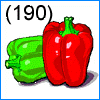We often hear that to help prevent cancer, we should eat a minimum of six fruits and vegetables daily. Although most provide fibre and are a healthier source of calories than most fatty foods, some fruits and veggies are a poor source of minerals, vitamins A and C and carotenoids.
A medium-sized apple(138 g = 1/3 lb) , for example, only contains about 8 mg of vitamin C. If that was your only source of vitamin C for the day, it would take more than 7 apples to meet the recommended daily allowance ( RDA ) of 60 mg, which by itself is considered by many to be a conservative amount. Apples are even worse sources of Vitamin A, each providing only about 70 of the 8000 international units( IU) recommended.
Keep in mind though, that apples are a good source of soluble fiber and may have , for all we know, a host of other unknown but beneficial compounds.
On the other hand, eat one sweet red pepper (medium sized = 113 g), and you ingest 226 mg of Vitamin C, probably more than what you need by any standard, and over 6700 IU of vitamin A, almost the full RDA. Similarly, just one mango(207 g) will provide you with an adequate supply of vitamin A ( over 8000 IU) and vitamin C ( almost 60 mg ). Half a cantaloupe ( 226 g ) is also an excellent source of both vitamins, as it provides 117 mg of C and almost 9000 IU of A.
Most people associate potassium with bananas. How it got that reputation is a mystery. Although it is not a poor source of the mineral, lima beans, kidney beans, lentils, avocados, spinach, parsley and potatoes all have a higher percent of potassium.
Another overated fruit is the orange. Although a 100 g orange almost meets the RDA of vitamin C, it is behind 4 vegetables and seven other fruits, many of which never get the deserved recognition. These include guava, with 3 times the percent of vitamin C found in oranges, and kiwis, which have about 60% more vitamin C than Florida's favorite fruit.
All comparisons below are on a per 100 g basis to account for discrepancies in fruits, nuts and vegetable size.
All vegetables compared are raw and include lima beans, artichokes, carrots, celery,collards,pak choi, broccoli,
potatoes,dandelion greens,chicory greens, parsley, beans, peas,sweet potatoes, lentils, tomatoes, cucumbers,
red and green peppers, onions, zucchini, Boston lettuce, Swiss chard, spinach,poi,red cabbage and corn.
Raw fruits compared include
apples,
apricots,
avocados,
bananas,
blueberries,
cantaloupes,
cherries,
chokeberries,
cranberries,
elderberries,
figs,
guavas,
kiwis,
lemons,
limes,
litchis,
loquats,
mangos,
oranges,
papayas,
peaches,
pears,
persimmons,
pineapples,
prickly pears,
raspberries,
strawberries,
and
watermelons.
Nuts compared include walnuts, hazelnuts, peanuts, brazil nuts, cashews(technically a fruit), almonds, chestnuts, pecans and pistachios,.




